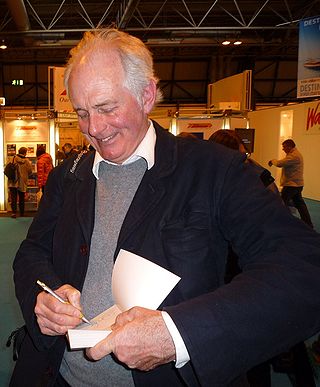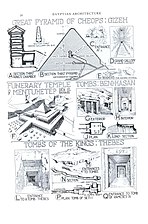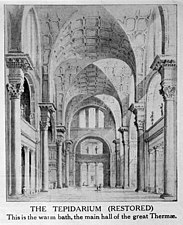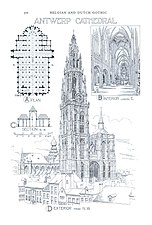
Medieval architecture is architecture common in the Middle Ages, and includes religious, civil, and military buildings. Styles include pre-Romanesque, Romanesque, and Gothic. While most of the surviving medieval architecture is to be seen in churches and castles, examples of civic and domestic architecture can be found throughout Europe, in manor houses, town halls, almshouses, bridges, and residential houses.

In architecture, an abacus is a flat slab forming the uppermost member or division of the capital of a column, above the bell. Its chief function is to provide a large supporting surface, tending to be wider than the capital, as an abutment to receive the weight of the arch or the architrave above. The diminutive of abacus, abaculus, is used to describe small mosaic tiles, also called abaciscus or tessera, used to create ornamental floors with detailed patterns of chequers or squares in a tessellated pavement.

Sir Banister Flight Fletcher was an English architect and architectural historian, as was his father, also named Banister Fletcher. They wrote the standard textbook A History of Architecture, which is also often referred to just as Banister Fletcher.

Daniel Gordon Raffan Cruickshank is a British art historian and BBC television presenter, with a special interest in the history of architecture.
After nearly a century of endeavour and negotiation which had been led by the Royal Institute of British Architects, a statutory Board of Architectural Education was formed under the Architects (Registration) Act, 1931. For the purposes of constituting the Board of Architectural Education the Act included a list of Schools of Architecture in the United Kingdom. The statutory Board was abolished in the 1990s, and when the Architects Act 1997 repealed the 1931 Act the statutory list of Schools of Architecture went with it.
Şevki Balmumcu was a Turkish architect who designed the Ankara Opera House.

A garbhagriha is the innermost sanctuary of Hindu and Jain temples, what may be called the "holy of holies" or "sanctum sanctorum".

Sir Hubert Shirley-Smith, CBE, BSc, MICE was a British civil engineer.

Banister Fletcher was an English architect and surveyor and Liberal politician who sat in the House of Commons from 1885 to 1886. He was extremely hardworking, and a prolific author besides many other interests. He is mainly remembered for A History of Architecture on the Comparative Method (1895), written with his son Sir Banister Fletcher, which remains in print.

Ramot Polin is part of the larger neighborhood of Ramot in northwest East Jerusalem. It was constructed by the Kollel Polen (Poland) in stages beginning in 1972, under the auspices of the Office for Building and Habitation, and is populated, as intended, mostly by Haredi Jewish families, including Breslov. The neighborhood contains 720 housing units of varying sizes.

Daibutsuyō is a Japanese religious architectural style which emerged in the late 12th or early 13th century. Together with Wayō and Zenshūyō, it is one of the three most significant styles developed by Japanese Buddhism on the basis of Chinese models.

Zenshūyō is a Japanese Buddhist architectural style derived from Chinese Song Dynasty architecture. Named after the Zen sect of Buddhism which brought it to Japan, it emerged in the late 12th or early 13th century. Together with Wayō and Daibutsuyō, it is one of the three most significant styles developed by Japanese Buddhism on the basis of Chinese models. Until World War II, this style was called karayō but, like the Daibutsuyō style, it was re-christened by Ōta Hirotarō, a 20th-century scholar. Its most typical features are a more or less linear layout of the garan, paneled doors hanging from hinges, intercolumnar tokyō, cusped windows, tail rafters, ornaments called kibana, and decorative pent roofs.

Setchūyō is an architectural style born in Japan during the Muromachi period from the fusion of elements from three different antecedent styles: wayō, daibutsuyō, and zenshūyō. It is exemplified by the main hall at Kakurin-ji. The combination of wayō and daibutsuyō in particular became so frequent that sometimes it is classed separately by scholars under the name Shin-wayō.
Raška architectural school, also known as the Raška style, or simply as the Raška school, is an ecclesiastical architectural style that flourished in the Serbian High Middle Ages, during the reign of the Nemanjić dynasty. The style is present in the notable Morača Monastery, Uvac monastery and Dobrilovina monastery, among many others. This style combines traditional Slavic architecture with early Christian church-design, and often utilizes a combination of stone and wood material.

St. Maria im Kapitol is an 11th-century Romanesque church located in the Kapitol-Viertel in the old town of Cologne, Germany. The name “im Kapitol“ refers to the Roman temple for the Capitoline Triad that was built on today’s site of the church in the first century. The Catholic church is based on the Church of the Nativity in Bethlehem, was dedicated to St. Mary and built between 1040 and 1065. It is one of twelve Romanesque churches built in Cologne during this period.
Michel Weill was a French architect who co-founded the Atelier LWD with Guy Lagneau and Jean Dimitrijevic, and was involved in many major projects in France and Africa. He worked with Lagneau and Dimitrijevic on the Musée-Maison de la Culture at Le Havre, a glass box surrounded by mechanical solar-control devices. Another project with Lagneau and Dimitrijevic was the Hôtel de France in Conakry, Guinea, a long building flanked by a rotunda. It was built of reinforced concrete panels with aluminum shutters.
The London Society is a British membership organisation established to encourage public interest and participation in urban planning and transport matters in London as well as to study and celebrate the capital's unique history and character. It is among the oldest civic societies in the United Kingdom.
Prunella Fraser was an architectural historian, writer, and archivist, and Fellow of the Society of Antiquaries of London. She worked on the cataloguing of architectural drawings at the Royal Institute of British Architects.
Murray Fraser is Professor of Architecture and Global Culture at the Bartlett School of Architecture, University College London (UCL).



















